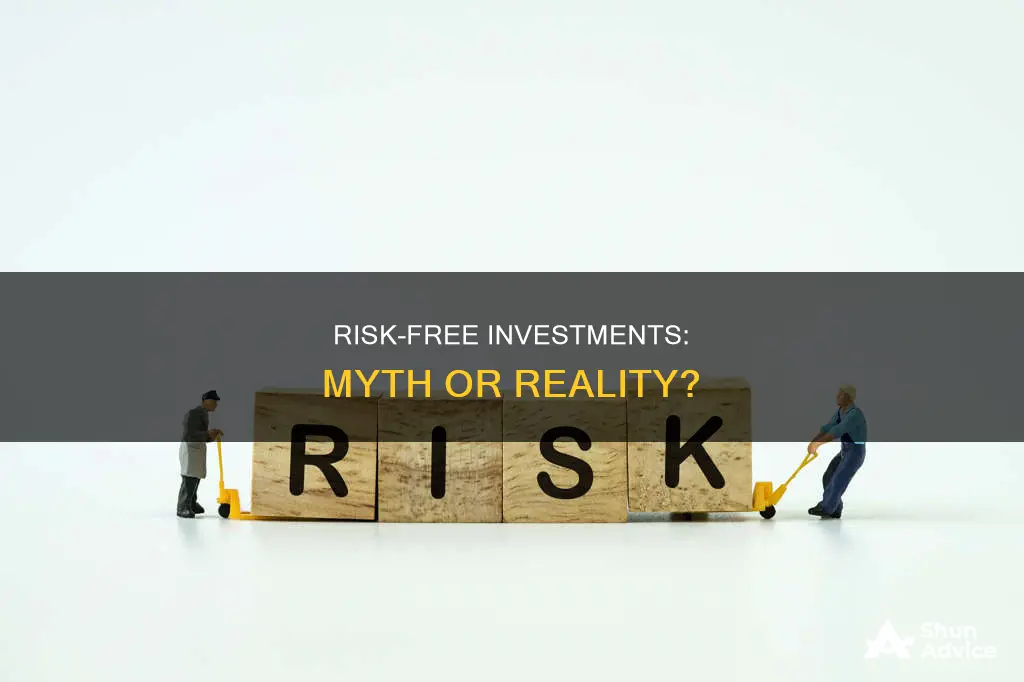
Risk-free investing is a myth. All investments carry some level of risk, and while certain investments are considered safer than others, no investment is entirely risk-free. Even the most conservative investments, such as savings accounts, cash, and government bonds, carry a risk of inflation and interest rate risk.
The risk-free rate of return is the theoretical rate of return of an investment with zero risk. In practice, this rate of return doesn't exist as every investment carries some amount of risk, even if that risk is small.
So, while there may be investments that are safer than others, it's important to remember that no investment is completely risk-free.
| Characteristics | Values |
|---|---|
| Risk-free rate of return | Theoretical rate of return of an investment with zero risk |
| Risk-free assets | Debt obligations issued by the U.S. Department of the Treasury, e.g. bonds, notes, and Treasury bills |
| Risk-averse investors | Those nearing retirement or anyone looking to balance out higher-risk investments |
| Inflation risk | Possibility that the return on investment will not keep up with inflation |
| Interest rate risk | Possibility that changes in interest rates will impact the value of investment |
| Liquidity risk | Inherent in certain savings products whose operation involves blocking capital for a long period |
| Counterparty risk | Financial operator, bank, or insurance company may go bankrupt or become insolvent |

Inflation risk
Other assets that have historically protected against the negative effects of inflation include commodities, index-linked bonds, REITs (real estate investment trusts), and a well-balanced and diversified shares portfolio.
India Nifty 50: Tracking Index Funds for Smart Investments
You may want to see also

Interest rate risk
When interest rates increase, the value of existing bonds typically falls, as newly issued bonds offer higher returns, making older, lower-yielding bonds less attractive. This is because the market value of existing bonds adjusts to align with the attractiveness of newly issued bonds offering higher rates. Conversely, when interest rates decline, the value of existing bonds rises, as their yields become more competitive compared to newer bonds issued at lower rates.
The extent of this risk depends on the bond's maturity and coupon rate. Longer-term bonds are more susceptible to interest rate fluctuations because investors are locked into a fixed rate for an extended period, making the bond's value more sensitive to interest rate changes. Bonds with lower coupon rates also tend to be more vulnerable to interest rate risk, as their lower interest payments are less appealing when rates rise.
Asian Equities: Why You Should Invest Now
You may want to see also

Liquidity risk
For banks and financial institutions, managing liquidity risk is crucial and is often regulated by frameworks such as Basel III, which enforces stringent liquidity standards to ensure financial stability and protect depositors. Corporations also need to carefully manage liquidity risk by ensuring they have sufficient cash or access to credit to meet their operational and financial obligations.
The repercussions of poorly managed liquidity risk can be severe and far-reaching. It can lead to financial losses, operational disruptions, and reputational damage. In extreme cases, liquidity risk can even drive an entity towards insolvency or bankruptcy.
To effectively manage liquidity risk, institutions and corporations should ensure the availability of sufficient cash, maintain a portfolio of high-quality liquid assets, employ rigorous cash flow forecasting, and diversify their funding sources.
Understanding the Makeup of a Modern Investment Portfolio
You may want to see also

Counterparty risk
For example, if you buy shares of a stock, the counterparty to that transaction could be the seller or an investor who sells those shares. In other words, the counterparty takes the opposite position in the same transaction.
In the context of investments, counterparty risk refers to the potential risk of loss arising from the failure of a financial entity to fulfil its obligations as agreed upon in a financial transaction. This risk is particularly important for institutional investors and market makers, who often deal with large sums of money, complex financial instruments, multiple assets, and longer-term contracts.
To limit their exposure to counterparty risk, institutional investors, securities dealers, and liquidity traders may employ strategies such as providing market liquidity, establishing complex credit arrangements, or entering into financial contracts like credit default swaps or collateral agreements.
It is worth noting that counterparty risk is not limited to institutional investors. Even in simple stock trades, there is a possibility that the other party may default on the transaction. Therefore, it is crucial for investors to assess the counterparty risk before engaging in any financial transaction.
What Makes a Registered Managed Investment Scheme a Disclosing Entity?
You may want to see also

Reinvestment risk
For example, an investor buys a 10-year $100,000 Treasury note (T-note) with an interest rate of 6%. The investor expects to earn $6,000 per year from the security. However, at the end of the first year, interest rates fall to 4%. If the investor buys another bond with the $6,000 received, they would only receive $240 annually instead of $360. Moreover, if interest rates increase and they sell the note before its maturity date, they risk losing part of the principal.
Callable bonds, which are typically redeemed when interest rates decline, are especially vulnerable to reinvestment risk.
To mitigate reinvestment risk, investors can consider the following strategies:
- Investing in non-callable or zero-coupon bonds
- Investing in longer-term securities
- Creating a bond ladder with securities of varying maturity dates
- Actively managed bond funds
- Evaluating current and future interest rate environments before selecting investments
Equity Derivatives: A Beginner's Guide to Investing
You may want to see also
Frequently asked questions
A risk-free investment is one that guarantees a return without the possibility of loss. However, in reality, there is no such thing as a completely risk-free investment.
Examples of low-risk investments include high-yield savings accounts, money market funds, certificates of deposit (CDs), and cash-value life insurance.
Diversifying your investments across different asset classes, such as stocks, bonds, and real estate, can help minimise risk and maximise returns.
Avoiding risk altogether can be risky as it may lead to missed opportunities for wealth growth. Historical data shows that those willing to take on some risk have the potential to earn higher returns.
While there is no such thing as a completely risk-free investment, diversification and long-term investing are effective strategies for reducing risk.







